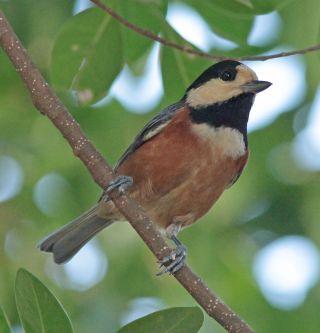And a Review of Autumn 2012 on Po Toi
I could only spend Tuesday on Po Toi this week, as a day tripper. It was quiet, only the Hoopoe from last week with Chestnut and Little Buntings.
It seems that autumn migration has come to an end for 2012, on Po Toi at least. So, a good time to review the whole autumn period.
And a great autumn to review, the best in my seven years on Po Toi since autumn 2006, better even than the other two good years 2007 and 2009. Better for both quantity and quality.
On the quality side, an unprecedented three HK Firsts or potential Firsts, Varied Tit in September, Hawfinch and Whistling Green Pigeon in November.



Hawfinch photo thanks to Chung Wing King and the finder, Chung Yung Tak
Whistling Green Pigeon photo thanks to Paul Kam
followed closely by two HK third records, Alstrom’s Warbler in October and Chinese Thrush in December, and other stars Fairy Pitta in September, Rosy Starling, Lesser Cuckoo and Humes’ Leaf Warbler in October and Bianchi’s Warbler in November. Here photos of all these except the last two





Fairy Pitta photo thanks to Andy Ho
Rosy Starling photo thanks to Allen Chan
So the quality was excellent. But the quantity was, for me, even better. Almost every species was present in sufficient numbers to be seen regularly. As a result, I consistently achieved higher daily species counts than in the past

For some commoner species, counts were consistently higher than all or most previous years, e.g. Daurian Redstart and Dusky Warbler


and numbers of other species such as Dollarbird, Black-naped Oriole, Red-flanked Bluetail, Eyebrowed and Brown-headed Thrush, Lanceolated and Raddes’ Warblers, Eurasian Siskin and Chestnut Bunting were at record or very high autumn levels.
Here four species which took the eye in autumn 2012 – male Daurian Redstart and Red-flanked Bluetail, Raddes’ Warbler and a mixed flock of Yellow-browed and Chestnut Buntings




So, the question arises, why? Why was autumn 2012 so good?
When answering this type of question, I always look first at the weather – was there anything remarkable this year? And the answer is no, nothing really remarkable. A very consistent September and October, regular but short spells of northerly winds in November but nothing at all unusual. Good weather for migration but nothing spectacular to bring birds into Hong Kong.
So, what could be the answer?
It could be just a chance event, but as a scientist, I don’t like that explanation.
A clue may lie in two of the potential HK Firsts – the Varied Tit and the Whistling Green Pigeon. Both species are not normally migrants. Both showed signs of being part of an irruption – a good breeding year when too many first year and adult birds survive for their normal territory to support, so some birds take flight, to the south and for Japan, to the west, trying to find enough food to survive the winter.
Maybe it was just a very good breeding summer in the north for many species, and there are just more birds around than usual.
That’s the answer I prefer, unless anyone can suggest another (other than the ‘chance event’).
So, maybe a good first half to the winter, So far, anyway
Back next March.
[
Last edited by wgeoff at 13/12/2012 09:58 ]


